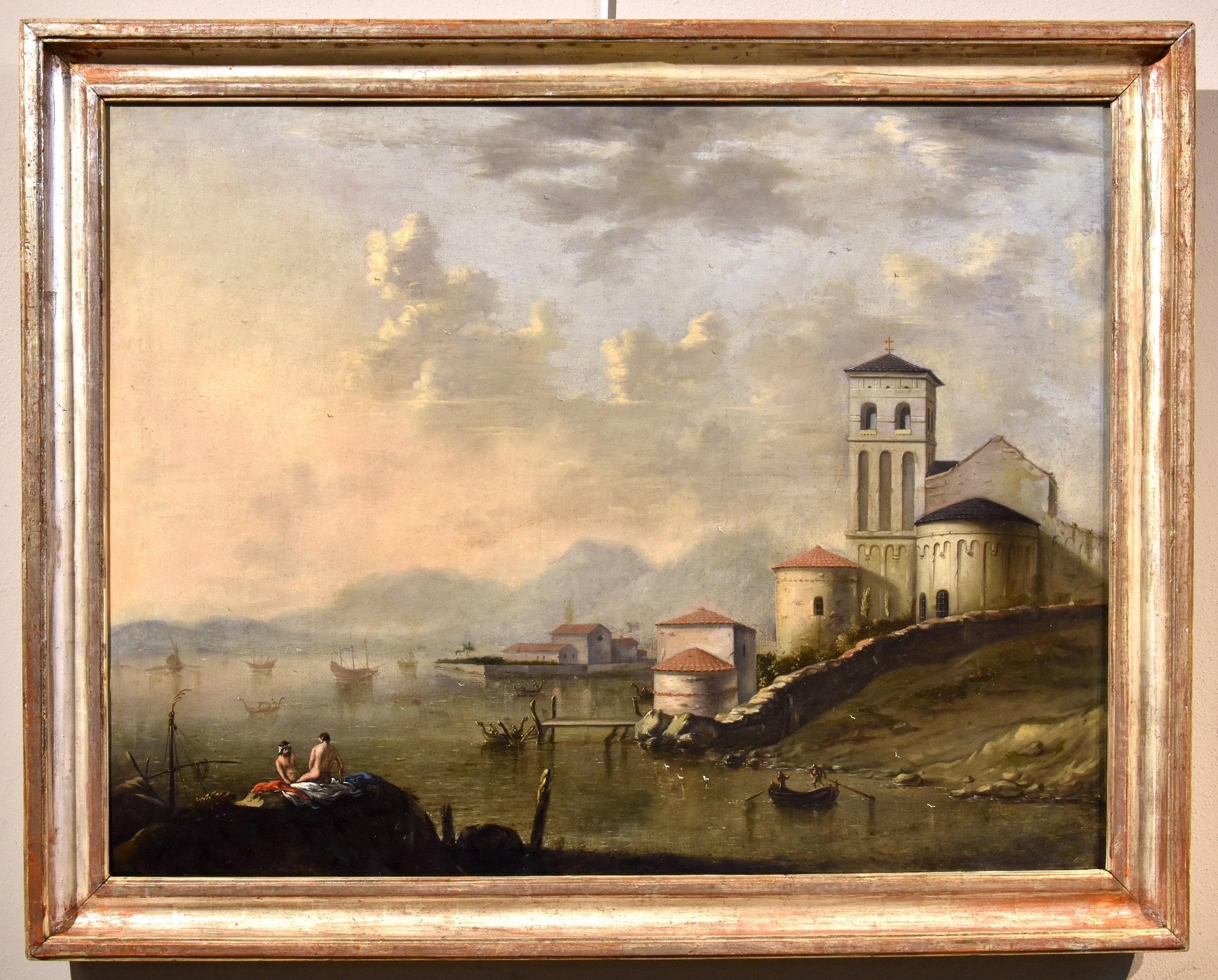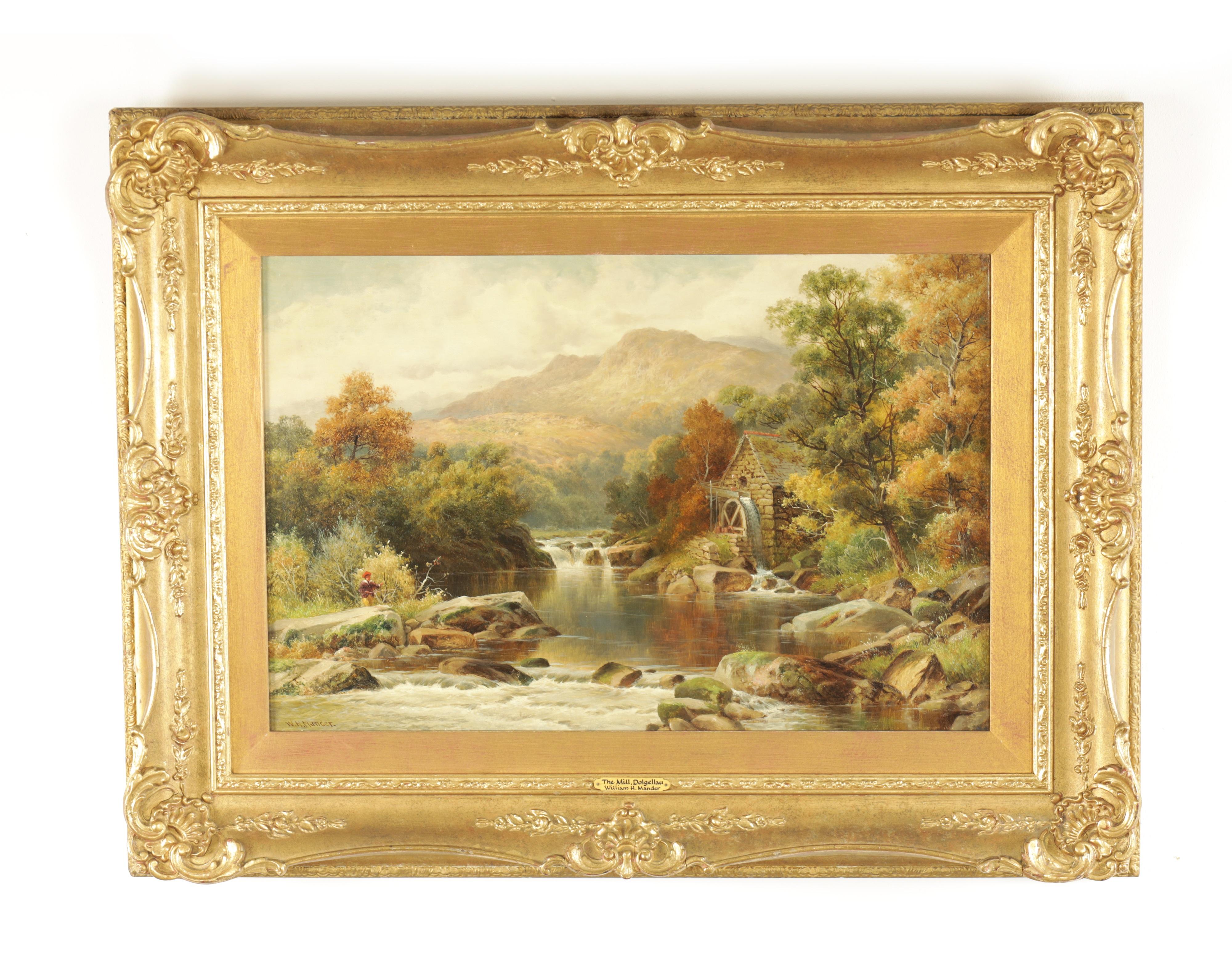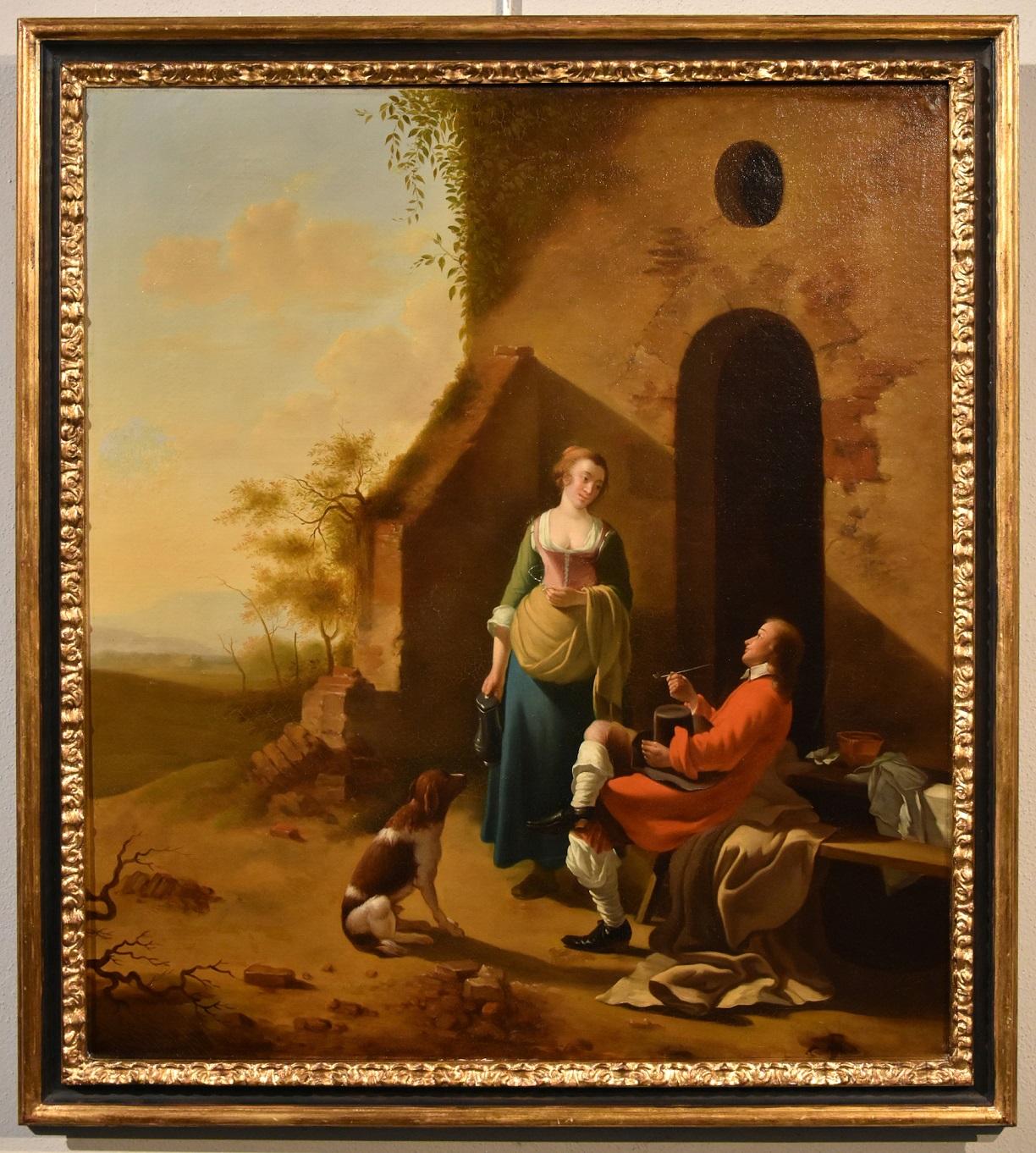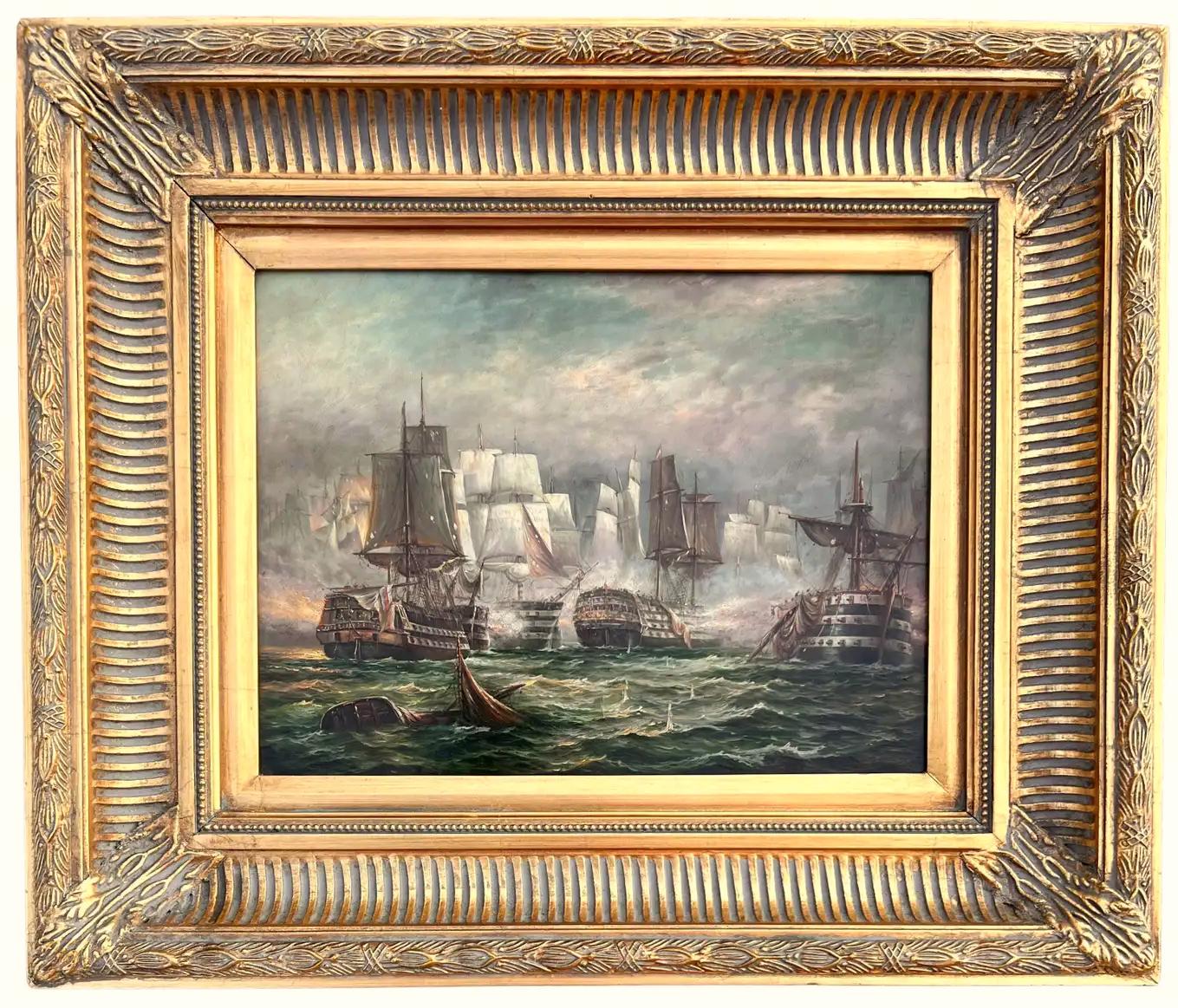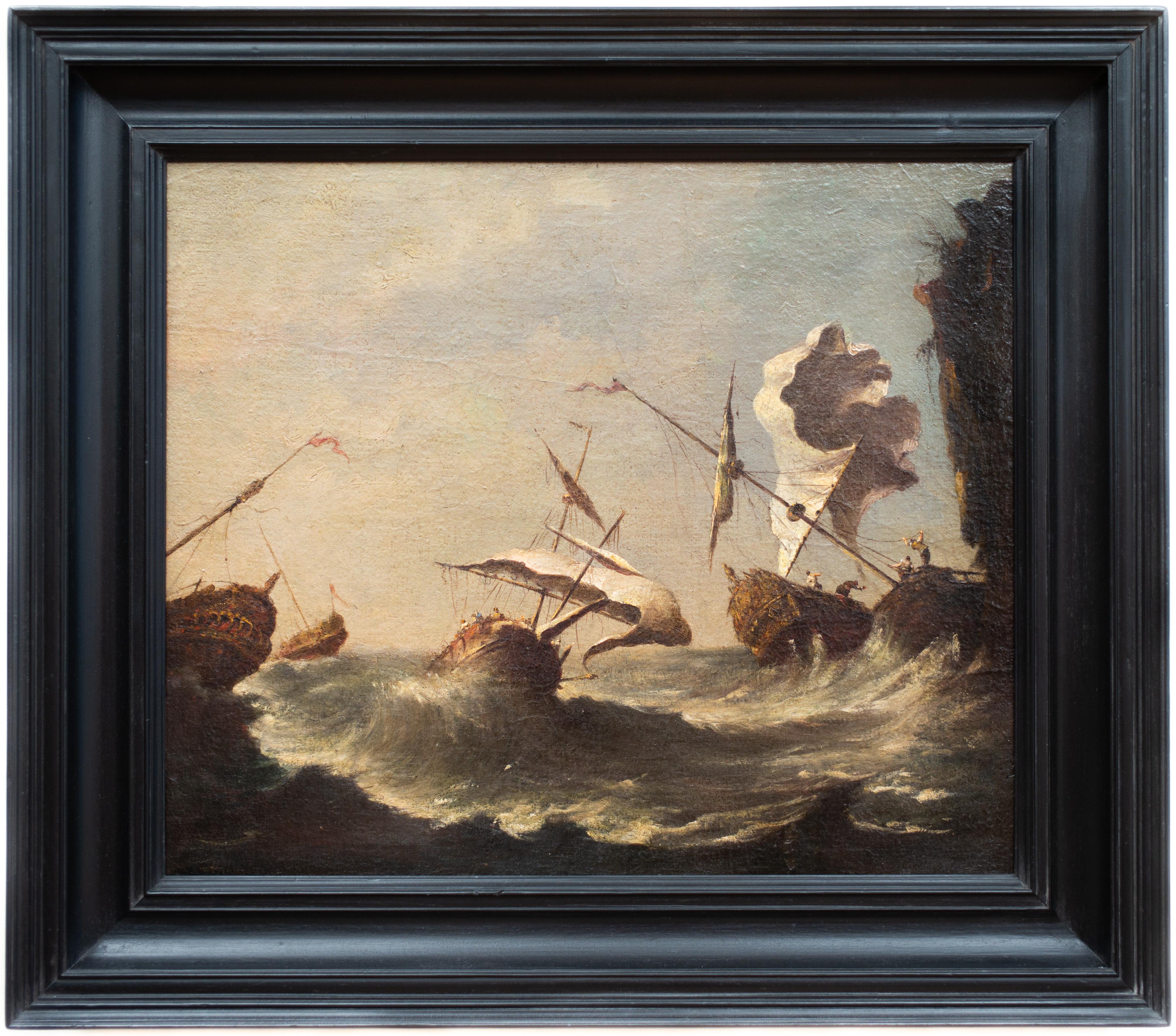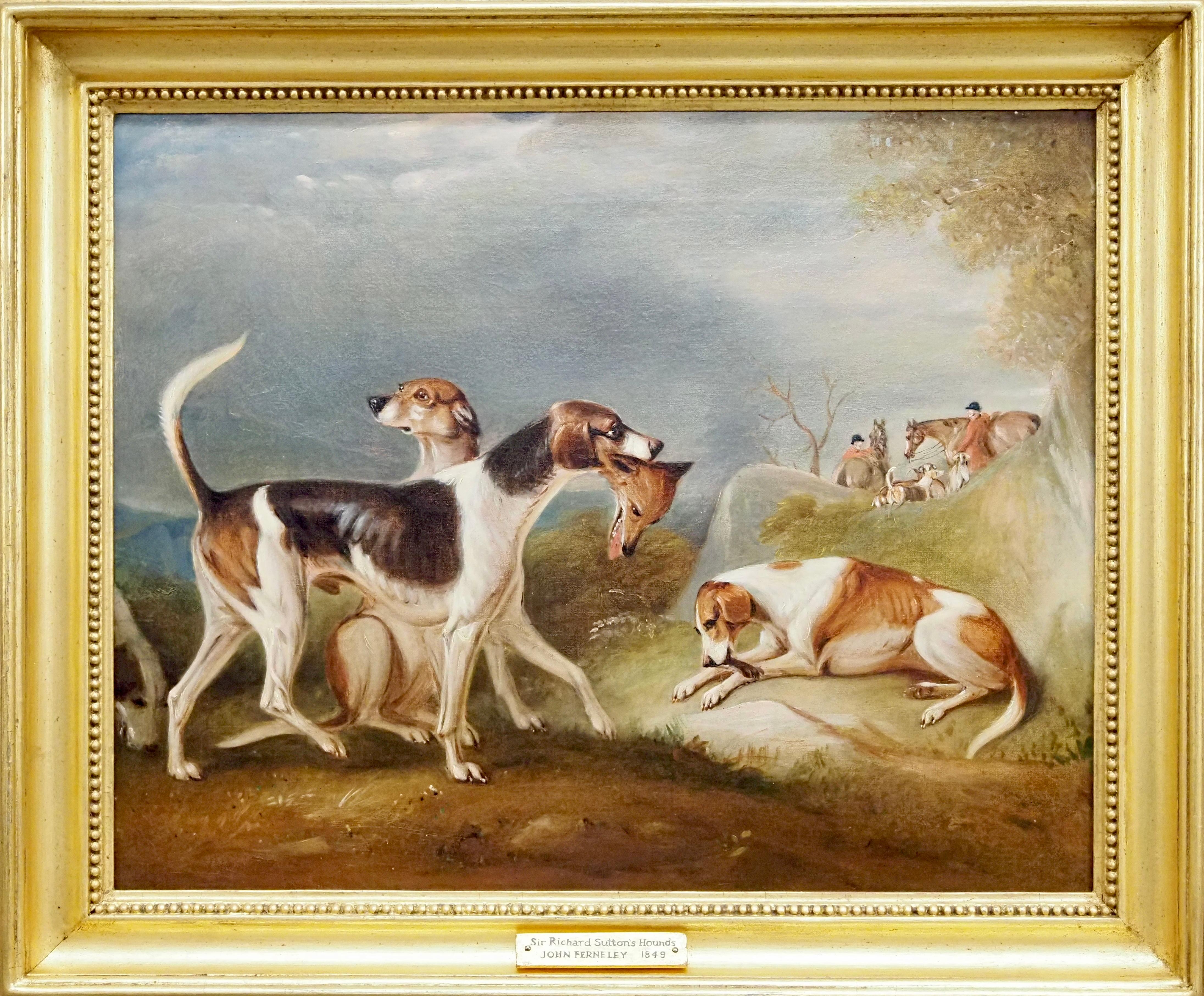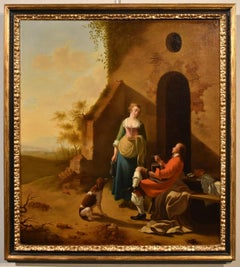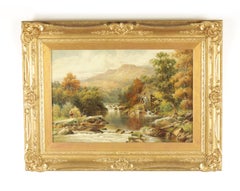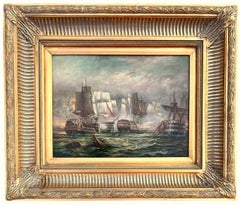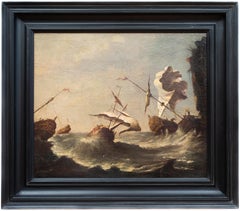Items Similar to The Resting Of Diana, Guillaume Courtois Known As 'il Borgognone' (1626 - 1679)
Want more images or videos?
Request additional images or videos from the seller
1 of 17
The Resting Of Diana, Guillaume Courtois Known As 'il Borgognone' (1626 - 1679)1640-1675
1640-1675
About the Item
Guillaume Courtois known as 'il Borgognone' (Saint Hippolyte 1626 - Rome 1679)
The Resting of Diana
Oil on canvas (97 x 70 cm. - Framed cm. 121 x 95)
The proposed painting, of exquisite quality and artistic level, is a work executed in the second half of the 17th century by an artist from the Roman area.
The episode illustrates the repose of the hunting goddess Diana, depicted asleep lying in the shade of a tree, half-naked with only a veil covering her pubis and lying on a blue sheet, after a hunt, with her spear still in her hands and her quiver lying in front of her.
The goddess, ready to enjoy the pleasures of a relaxing sleep, is surrounded and protected by a host of fluttering cupids, some are playing with one of her hounds, some are amusing themselves by riding a branch, while others are intent on holding a red drape, as if to protect her intimacy from possible prying eyes.
An analysis of the stylistic and figurative characteristics, as mentioned above, shows that it belongs to the Roman school of the mid 17th century, capable of expressing a refined style, and succeeding in blending the Baroque language, by definition sumptuous, with elements of classicist ancestry.
It is therefore a painting of immediate beauty, capable of combining remarkable pictorial finesse with a scenic construction capable of satisfying even the most demanding gaze.
In particular, the work shows clear reminiscences with the Cortonese sphere, specifically with the figure of Guillaume Courtois known as 'il Borgognone' (Saint Hippolyte 1626 - Rome 1679). In his painting, and thus also in the proposed work, a classicist figurative culture emerges with influences from typically Baroque legacies, from which his training in the workshop of Pietro da Cortona is evident.
The painting, which is in a good state of conservation, shows a slight patina of time that we decided not to clean, as the work remains perfectly legible. It presents a professionally executed rintelo, and is complete with a pleasant period carved wooden frame.
ADDITIONAL INFORMATION:
The painting is sold with a certificate of authenticity and descriptive iconographic document.
We take care of and organise the transport of the purchased works, both for Italy and abroad, through professional and insured carriers.
Should you have the desire to see this or other works in person, we will be happy to welcome you to our new gallery by Antichità Castelbarco SRLS in Riva del Garda, Viale Giuseppe Canella 18. We are waiting for you!
Contact us for any information or to arrange a visit, we will be happy to answer you.
- Attributed to:Guillaume Courtois known as 'il Borgognone' (Saint Hippolyte 1626 - Rome 1679) (1626 - 1679)
- Creation Year:1640-1675
- Dimensions:Height: 47.64 in (121 cm)Width: 37.41 in (95 cm)
- Medium:
- Movement & Style:
- Period:
- Condition:
- Gallery Location:Riva del Garda, IT
- Reference Number:1stDibs: LU988112700312
About the Seller
4.9
Platinum Seller
Premium sellers with a 4.7+ rating and 24-hour response times
Established in 2017
1stDibs seller since 2018
238 sales on 1stDibs
Typical response time: <1 hour
- ShippingRetrieving quote...Shipping from: Riva del Garda, Italy
- Return Policy
Authenticity Guarantee
In the unlikely event there’s an issue with an item’s authenticity, contact us within 1 year for a full refund. DetailsMoney-Back Guarantee
If your item is not as described, is damaged in transit, or does not arrive, contact us within 7 days for a full refund. Details24-Hour Cancellation
You have a 24-hour grace period in which to reconsider your purchase, with no questions asked.Vetted Professional Sellers
Our world-class sellers must adhere to strict standards for service and quality, maintaining the integrity of our listings.Price-Match Guarantee
If you find that a seller listed the same item for a lower price elsewhere, we’ll match it.Trusted Global Delivery
Our best-in-class carrier network provides specialized shipping options worldwide, including custom delivery.More From This Seller
View AllLandscape See Paint Oil on canvas Flemish Old master 18th Century Italian Art
Located in Riva del Garda, IT
Flemish painter active in Italy in the eighteenth century
Coastal landscape of the Mediterranean with architectures and figures
Oil painting on canvas (69 x 88 cm., in frame 80 x 100 cm.)
The suggestive view proposed depicts a coastal view with a bay and the ruins of an ancient building, probably a monastery or a church, and in the background another building with a garden surrounded by high walls close to the shore.
The type of landscape, typical of the southern Italian environment, and the intimate atmosphere that welcomes the scene, attributes the authorship of the work to a landscape painter active in the eighteenth century, presumably in Italy in this period, with immediate references to the Dutch school , and in particular to the production of Jacob de Heusch and above all of Gaspar van Wittel, considered the progenitor of Italian landscape painting.
In fact, in the rendering of the architectural details, in the purity with which the buildings have been reconstructed, as well as in the atmosphere that encompasses the entire landscape, a marked correspondence to the so-called "Vanvitellian realism" can be seen: in fact, a comparison with a certain series of views which the Dutchman...
Category
18th Century Old Masters Paintings
Materials
Oil
$6,896 Sale Price
20% Off
Galante Scene Vermeer d'Utrecht Paint Oil on canvas 18th Century Flemish Old Art
Located in Riva del Garda, IT
Flemish painter of the 18th century - Follower of Jan van der Meer, called Vermeer d'Utrecht (Schoonhoven, verses 1630 - 1692)
Courtship scene at the entrance of an inn
oil on canvas, 70 x 62 cm. (with frame 80 x 72 cm.)
This pleasant genre scene, depicting a young innkeeper conversing amiably with a gentleman as she prepares to serve him wine in a glass goblet that she still holds in her hand, is inspired by the painting made in 1653 by the Dutch painter Jan van der Meer, known as Vermeer d'Utrecht, and today kept in Paris at the Louvre Museum.
Set outside an inn or a post station, the scene illustrates the theme of seduction, with the young waitress being courted by the client, a charming traveler with a changing red cloak, who tries to charm her.
Yes, it is a work that harmoniously combines the painter's Dutch origins, with the stylistic characters learned during his training in his homeland, with the Italian-like characters learned during his trip to Italy around 1655. In Rome, in particular, he met and collaborated with various authors of the Bamboccianti school, first of all Jan Miel...
Category
18th Century Old Masters Paintings
Materials
Oil
$8,348 Sale Price
20% Off
Rotterdam Port See Italian Paint Oil on canvas 18th Century Old master Flemish
Located in Riva del Garda, IT
Pair of views of Rotterdam: The Stock Exchange building / View of the canal with the old port
Eighteenth-century Vedutist painter
oils on canvas
47 x 66 cm. - with frame 56 x 75 cm.
This pleasant pair of paintings depict two glimpses of the city of Rotterdam, investigated here as vivid documentaries of the habits and customs from the public life of the wealthy Dutch port city, as well as one of the founders of the Dutch East India Company, is an excellent example of 18th century Vedutism
We see, in particular, in the first work the monumental Palazzo della Borsa (defined as Il Beurs), designed by the architect Adriaen van der Werff in Westnieuwland, initially a place destined for legislation on trade, where merchant-bankers met periodically to exchange securities credit and enter into sales; it is located on the bank of the Nordblaak River and shot with the Gaapers Bridge in the foreground.
The second work immortalizes the docking of the ancient port of Rotterdam, with the foreground view of the two city gates (the Wester Old Hoofdpoort on the left and the Ooster Oude Hoofdpoort on the right); in the background on the left the St. Laurenskerk (Church of San Lorenzo), also called the Great Church of Rotterdam, is the only medieval structure, while on the right the English Church.
Very well executed, characterized by a marked brightness and a chromatic range with bright colors and highlighted by the contrast between lights and shadows, our canvases are a very interesting testimony of eighteenth-century Rotterdam, portraying two of the views that have historically influenced a lot on economic history of the city.
We can attribute the authorship to an author of the full eighteenth century, inspired by the pictorial style of the Italian landscape painters and whose iconography was presumably drawn from the numerous prints with perspective views made through the optical cameras.
In particular, these views of Rotterdam draw their iconographic origin from a collection of perspective prints of the most influential European cities, made by the engraver Johann Balthasar Probst (1732-1801), characterized by a remarkable refinement in the line, at the service of a sense of perspective of undoubted value, and above all characterized by a strong Nordic taste.
Descendant of a large family of Augsburg engravers, Probst contributed to making his workshop an important European publishing center between the 17th and 18th centuries, among the major German print publishers in the first half of the 18th century.
Despite his travels, including in Italy, between Venice, Rome and Naples, not all the cities he portrayed were drawn from life but taken from earlier prints and drawings and filtered through northern European clichés.
Many of these engravings have been lost and are now difficult to find on the antiques market.
Category
18th Century Old Masters Paintings
Materials
Oil
$10,647 Sale Price
20% Off
Landscape Zuccarelli Paint Oil on canvas Old master 18th Century Italian View
By Francesco Zuccarelli (Pitigliano 1702 - Florence 1788)
Located in Riva del Garda, IT
Francesco Zuccarelli (Pitigliano 1702 - Florence 1788), circle of
Landscape with river and resting shepherds
First half of the 18th century
oil painting on canvas
cm. 60 x 93, within a carved and gilded wooden frame cm. 75 x 108
This delightful landscape view animated by a family of shepherds who rest from their daily duties should be compared to the hand of Francesco Zuccarelli (Pitigliano 1702 - Florence 1788);
In the landscapes painted by Zuccarelli the world is crystallized, frozen in a moment of idyllic quiet,
where the 'Arcadian' sense of the landscape is rendered with that pictorial vivacity, chromatic lightness and compositional grace that we find in its entirety in his painting.
By way of comparison we can compare our canvas to other compositions, including:
- Landscape with river and resting shepherds, Accademia Carrara, Bergamo
- Landscape with bridge and horseman, Accademia Carrara, Bergamo
- Landscape with river, village, fisherman and shepherdesses' (Christie's, London May 1960,
- Landscape with figures, Accademia Carrara,
- Landscape with knight and figures, Accademia Carrara
Tuscan by origin, Francesco Zuccarelli trained first in Florence with the landscape architect Paolo Anesi...
Category
18th Century Old Masters Paintings
Materials
Oil
$8,409 Sale Price
20% Off
Carnival Rome Navona square Cerquozzi 17th Century Paint Oil on canvas Italy
Located in Riva del Garda, IT
Carnival scene in 17th-century Rome (in Piazza Navona)
Michelangelo Cerquozzi (Rome 1602 – Rome 1660) workshop
Roman school of bamboccianti (mid-17th century)
Oil on canvas
74 x 96...
Category
17th Century Old Masters Paintings
Materials
Oil
$10,405 Sale Price
20% Off
Van Bloemen Landscape Rome Paint 17/18th Century Oil on canvas Old master Italy
Located in Riva del Garda, IT
Antichità Castelbarco SRLS is proud to present:
Painting depicting "View of Rome with countryside scene with ancient ruins, with the Palatine from via dei Cerchi", work of high qual...
Category
17th Century Old Masters Paintings
Materials
Oil
$8,329 Sale Price
20% Off
You May Also Like
The Mill, Dolgellau, Wales , William Henry Mander 19th century oil painting
By William Henry Mander
Located in York, GB
The Mill, Dolgellau wales William Henry Mander 19th century oil painting
A fine oil on canvas painting of The Mill, Dolgellau, by the renowned artist William Henry Mander
Dolgel...
Category
19th Century Old Masters Landscape Paintings
Materials
Oil
A Lively Naval Engagement
Located in Wiscasett, ME
Oil on panel measuring 21" x 24.5," including the frame. The painting is signed in the lower right corner, but we cannot attribute the signature. Probably dating from the late 19th ...
Category
Late 19th Century Old Masters Landscape Paintings
Materials
Oil
Shipping in Stormy Waters, Attributed to Italian Artist Francesco Guardi
By Francesco Guardi
Located in Stockholm, SE
The splendour of the tragic sea
Francesco Guardi and maritime painting in Venetian art
No Venetian painter was a stranger to the sea. After all, Venice was not only one of the most prominent ports of the Mediterranean, but indeed a city literally submerged in the ocean from time to time. Curiously however, the famous Venetian school of painting showed little interest in maritime motifs, favouring scenes from the iconic architecture of the city rather than seascapes. That is why this painting is a particularly interesting window into not only the painter Francesco Guardi himself – but to the significance of the element of water in art history, in absence as well as in the centre of attention.
Whether it be calm, sunny days with stunning views of the palaces alongside the canals of Venice or – more rarely – stormy shipwrecking tragedies at sea, water as a unifying element is integral to the works of painter Francesco Guardi (1712–1793). During his lifetime, Venetian art saw many of its greatest triumphs with names like Tiepolo or Canaletto gaining international recognition and firmly establishing Venice as one of the most vibrant artistic communities of Europe. While the city itself already in the 18th century was something of an early tourist spot where aristocrats and high society visited on their grand tour or travels, the artists too contributed to the fame and their work spread the image of Venice as the city of romance and leisure to an international audience, many of whom could never visit in person.
Still today, the iconic image of Venice with its whimsical array of palaces, churches and other historic buildings is much influenced by these artists, many of whom have stood the test of time like very well and remain some of the most beloved in all of art history. It was not primarily subtility, intellectual meanings or moral ideals that the Venetian art tried to capture; instead it was the sheer vibrancy of life and the fast-paced city with crumbling palaces and festive people that made this atmosphere so special. Of course, Venice could count painters in most genres among its residents, from portraiture to religious motifs, history painting and much else. Still, it is the Vedutas and views of the city that seems to have etched itself into our memory more than anything else, not least in the tradition of Canaletto who was perhaps the undisputed master of all Venetian painters.
Born into his profession, Francesco lived and breathed painting all his life. His father, the painter Domenico Guardi (1678–1716) died when Francesco was just a small child, yet both he and his brothers Niccolò and Gian Antonio continued in their fathers’ footsteps. The Guardi family belonged to the nobility and originated from the mountainous area of Trentino, not far from the Alps. The brothers worked together on more challenging commissions and supported each other in the manner typical of family workshops or networks of artists. Their sister Maria Cecilia married no other than the artist Giovanni Battista Tiepolo himself, linking the family to the most renowned Venetian name of the time. During almost a decade, Guardi worked in the studio of Michele Giovanni Marieschi, sometimes simply known as Michiel, a painted similar in both style and motif. Canaletto is, however, the artist Guardi is most often compared to since they shared a mutual fascination for depicting the architecture and cityscape of Venice.
During the course of his career, Guardi tried his hand in many different genres. He was as swift in painting landscapes, Vedutas of Venice, sacred motifs, interiors and architectural compositions as he was in a number of other motifs. His style is typical of the Venetian school but also distinct and personal once we look a little closer. There is an absolute certainty in the composition, the choice of which sometimes feels like that of a carefully calculated photograph – yet it is also very painterly, in the best sense of the word: fluid, bold, sensitive and full of character. The brushwork is rapid, intense, seemingly careless and extraordinarily minute at the same time; fresh and planned in a very enjoyable mixture. His interiors often capture the breath-taking spacious glamour of the palaces and all their exquisite decor. He usually constructed the motif through remarkably simple, almost spontaneous yet intuitively precise strokes and shapes. The result was a festive, high-spirited atmospheric quality, far away from the sterile and exact likeness that other painters fell victim to when trying to copy Canaletto.
The painting here has nothing of the city of Venice in it. On the contrary, we seem to be transported far away into the solitary ocean, with no architecture, nothing to hold on to – only the roaring sea and the dangerous cliffs upon which the ships are just moments away from being crushed upon. It is a maritime composition evoking both Flemish and Italian precursors, in the proud tradition of maritime painting that for centuries formed a crucial part of our visual culture.
This genre of painting is today curiously overlooked, compared to how esteemed and meaningful it was when our relationship to the sea was far more natural than it is today. When both people and goods travelled by water, and many nations and cities – Venice among them – depended entirely on sea fare, the existential connection to the ocean was much more natural and integrated into the imagination. The schools and traditions of maritime art are as manifold as there are countries connected to the sea, and all reflect the need to process the dangers and wonders of the ocean.
It could symbolize opportunity, the exciting prospects of a new countries and adventures, prospering trade, beautiful scenery as well as war and tragedy, loss of life, danger and doom. To say that water is ambivalent in nature is an understatement, and these many layers were something that artists explored in the most wondrous ways. Perhaps it takes a bit more time for the modern eye to identify the different nuances and qualities of historic maritime paintings, they may on first impression seem hard to differentiate from each other. But when allowing these motifs to unfold and tell stories of the sea in both fiction and reality – or somewhere in between – we are awarded with an understanding of how the oceans truly built our world.
In Guardi’s interpretation, we see an almost theatrically arranged shipwrecking scene. No less than five ships are depicted right in the moment of utter disaster. Caught in a violent storm, the waves have driven them to a shore of sharp cliffs and if not swallowed by the waves, crushing against the cliffs seems to be the only outcome. The large wooden ships are impressively decorated with elaborate sculpture, and in fact relics already during Guardi’s lifetime. They are in fact typical of Dutch and Flemish 17th century ships, giving us a clue to where he got the inspiration from. Guardi must have seen examples of Flemish maritime art, that made him curious about these particular motifs. One is reminded of Flemish painters like Willem van de Velde and Ludolf Backhuysen, and this very painting has indeed been mistakenly attributed to Matthieu van Plattenberg...
Category
18th Century Old Masters Landscape Paintings
Materials
Canvas, Oil
$46,421 Sale Price
32% Off
Free Shipping
Sir Richard Sutton's foxhounds
By John Ferneley Senior
Located in Stoke, Hampshire
John Ferneley Snr (1782-1860 Melton Mowbray)
Sir Richard Sutton's foxhounds
signed J. Ferneley lower right
Oil on canvas
Canvas Size 16 1/8 x 20 1/2 in
Framed Size 21 x 25 in
Proven...
Category
18th Century Old Masters Animal Paintings
Materials
Oil
$8,402 Sale Price
24% Off
Mid Century Dutch Windmill Original Oil in Dutch Impressionist Style
Located in Soquel, CA
Mid Century Dutch Windmill Original Oil in Dutch Impressionist Style
Colorful French impressionist style oil painting by F. Simont (Dutch 19th/20t...
Category
1950s Old Masters Landscape Paintings
Materials
Linen, Oil, Stretcher Bars
17th Century by Jacob de Heusch Pair of Landscapes Oil on Canvas
Located in Milano, Lombardia
Jacob De Heusch (Utrecht, Netherlands, 1657 – Amsterdam, Netherlands, 1701)
Title: Pair of Landscapes
Medium: Oil on canvas
Dimensions: without frame 50 x 8...
Category
17th Century Old Masters Landscape Paintings
Materials
Canvas, Oil
Recently Viewed
View AllMore Ways To Browse
Naked Person
Roman Baroque Painting
Master Of The Hunt
Cupid Painting
Wes Hunting
Sleeping Beauty Painting
Painting With Cupids
Oil Painting Diana
Antique Goddess Painting
Painting Italian Veil
Diana Of The Hunt
17th Carved Saint
Oil Painting Cupid
Roman Spear
Cupid Oil On Canvas
Diana Goddess Of Hunting
Master Of Hounds
Sleeping Cupid
